The role of HR in succession planning should go beyond paperwork and processes—yet all too often, others in the organization, including the C-suite, view it that way. This disconnect can leave organizations unprepared for critical leadership transitions, with the true power of HR’s strategic influence going untapped.
This is evident in the significant gaps in how HR leaders view the state of succession planning within their organization compared with their non-HR peers. According to research from SHRM, nearly all business leaders (98%) with a succession plan say their organization follows through on these plans, compared to 63% of HR professionals, who are more likely to recognize the lost opportunity to be more intentional with it.
This discrepancy highlights a common gap in collaboration between leadership and HR. “Often the execs work in a silo,” says Betterworks’ Principal Program Architect Nicolette Schumacher. “They task HR with the administrative part of it — but then they’re missing out on a lot of key information that could really help them sustain a succession plan over a longer period of time.”
As an HR leader, you can shape the future of your organization by promoting leadership continuity, aligning talent development strategy with the company’s broader business objectives, and building a resilient, diverse leadership pipeline.
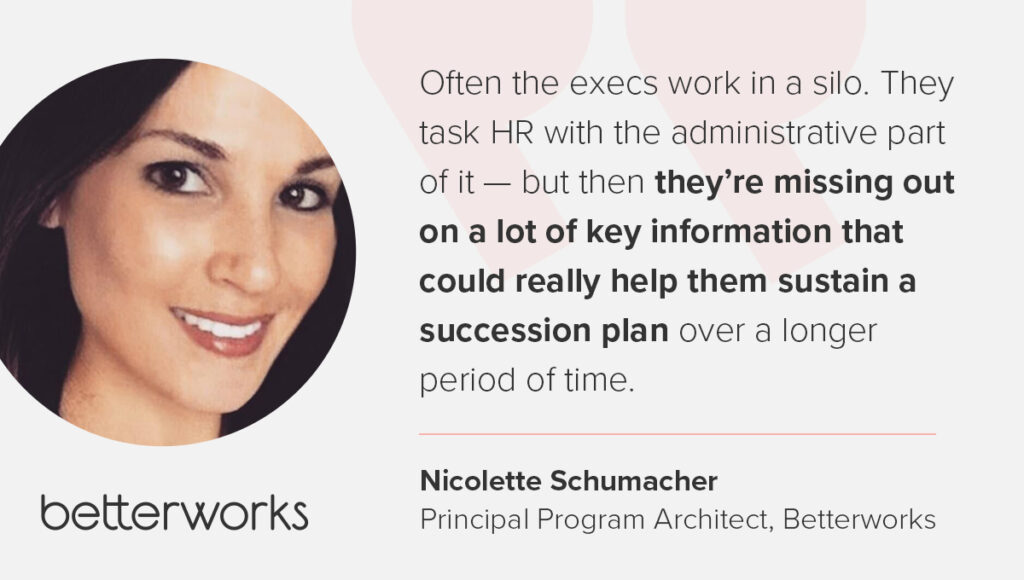
Why succession planning should be a strategic priority
Effective succession planning is more than just creating a backup plan for leadership vacancies. It’s a critical driver of a company’s long-term growth and stability.
Ensure leadership continuity and minimize disruption
When key roles suddenly become vacant, the impact on the business can be significant, leading to operational slowdowns and lost momentum. Succession planning promotes leadership continuity by having well-prepared individuals ready to step into critical positions at a moment’s notice. This proactive approach helps avoid costly disruptions and keeps the organization moving forward, even during periods of transition.
Support organizational agility and growth
A strong succession plan fosters organizational agility by developing a pipeline of leaders who are prepared to take on new challenges. As markets and business needs change, having employees ready to step into leadership roles enables the organization to pivot quickly and stay competitive. This strategic readiness supports long-term growth by ensuring that leadership transitions align with evolving business goals.
Boost employee retention and engagement
Succession planning isn’t just about filling roles — it’s also a powerful tool for retaining top talent. Employees who can see a clear path forward are more likely to be engaged and motivated to stay with the company. Investing in leadership development and providing employees with opportunities to grow creates a culture of growth and advancement, which leads to higher retention and a more loyal, productive workforce.
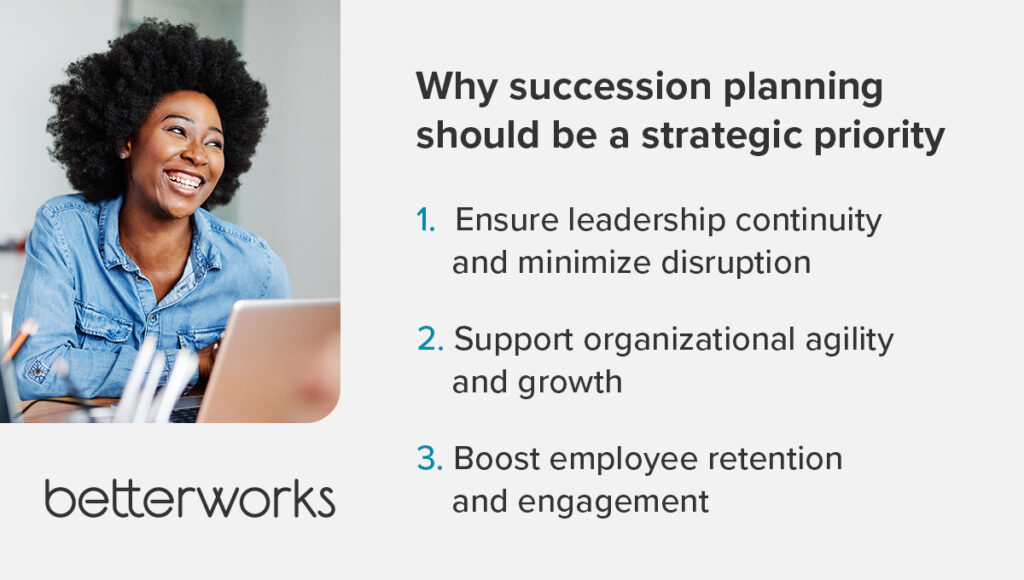
4 key HR responsibilities in the succession planning process
As an HR leader, your role in succession planning goes beyond administrative tasks — it’s about establishing a workforce transformation planning framework to build a future-ready organization. By strategically managing leadership development, you ensure that critical roles are filled with the right talent at the right time. HR must take ownership of these four responsibilities to create a robust and sustainable succession planning process.
Identifying critical roles
A key part of succession planning is identifying the roles critical to your organization’s success. These aren’t just senior leadership positions — they’re the roles that, if left unfilled, could disrupt the business. Critical roles could range from high-level executive positions to highly specialized technical jobs that directly impact strategic goals.
It’s your responsibility to assess which positions carry this weight, and to make sure you have a robust succession plan in place for each of them. By using performance data and skills assessments, you can identify and develop the right people to step into these vital roles when the time comes.
Defining and identifying high-potential employees
Defining “high-potential” means identifying individuals who demonstrate the skills, drive, and aptitude necessary to take on greater responsibilities within the organization. These employees often exhibit qualities such as strong communication, adaptability, and a commitment to continuous learning.
Establish criteria that encompass both current performance and future potential, using a combination of quantitative assessments, such as performance metrics, and qualitative evaluations, such as manager feedback and peer reviews.
Creating personalized development plans
Once high-potential employees are identified, the next step is to nurture their growth. HR’s role in leadership development isn’t to create personalized development plans directly, but to establish the framework and resources that enable managers to do so effectively.
Empower managers to craft development plans tailored to their team members’ individual strengths and growth areas. These plans should align with both the organization’s strategic business and leadership needs and the personal ambitions of high-potential employees. Work with managers to create targeted talent development plans, including opportunities for mentorship, training, and stretch assignments that challenge these individuals to expand their capabilities. Equip managers with the resources they need to provide regular progress evaluations and constructive feedback to high-potential employees on their teams.
Tracking progress and readiness
A successful succession plan is not static — it requires ongoing monitoring and adaptation. While the day-to-day tracking of employee progress lives with managers, HR’s role is to create the framework and oversight for this process. You provide the tools, data-driven evaluation methods, and guidelines that enable managers to continuously assess the progress of their high-potential team members.
HR oversees the broader succession strategy, ensuring that managers use this framework to evaluate leadership readiness and development. By regularly reviewing progress reports and ensuring that the evaluation criteria are applied consistently, you can help keep succession plans on track and aligned with the organization’s evolving goals. This oversight allows for necessary adjustments to development plans, keeping the leadership pipeline robust and responsive to future needs.
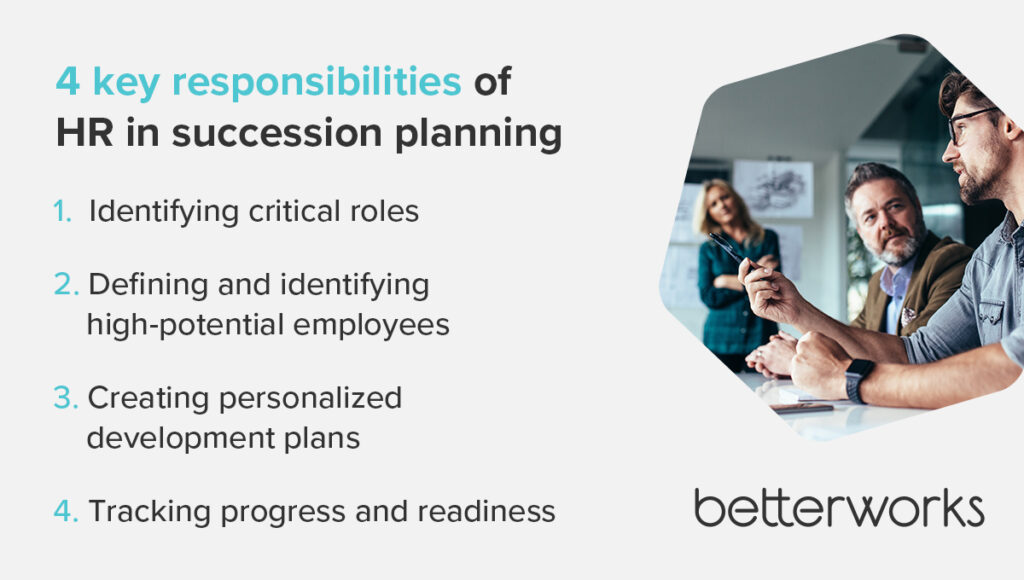
5 challenges HR faces in succession planning
Effective succession planning demands foresight, strategy, and the ability to overcome complex challenges. You’re often faced with competing priorities, from nurturing internal talent to addressing sudden leadership vacancies, all while ensuring the process is fair and inclusive. Watch out for these common hurdles you may encounter in succession planning.
Managing unforeseen leadership transitions
Leadership transitions can have far-reaching impacts on multiple departments and overall organizational stability. These transitions — whether due to resignations, health issues, or other unforeseen events — require an agile and well-prepared response. However, many HR teams find themselves reacting to such changes rather than proactively planning for them.
“Typically, it’s somewhat reactive in nature,” Nicolette says. “A more modern approach that we’re seeing emerge is putting in the time and effort to create a more agile organization that always has top talent identified, nurtured, and ready to take over any role that becomes vacant.” Effective leadership succession planning requires up-to-date, comprehensive plans that account for key leadership roles and potential successors.
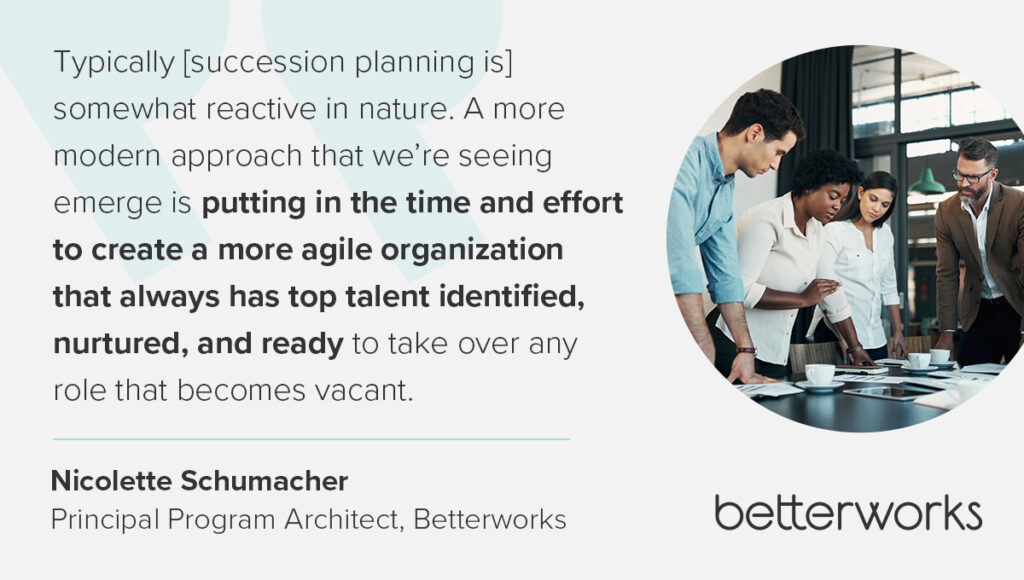
Addressing the outflux of baby boomers from the workforce
The mass retirement of baby boomers is creating a leadership vacuum across industries. In 2024 alone, over 11,000 Americans will turn 65 each day. Looking at trends, researchers estimate that as many as 6.3 million Americans could retire each year for the next four years — taking with them years of experience and institutional knowledge.
The challenge is not only to fill these roles but to ensure the transfer of knowledge to the next generation of leaders. This requires proactive leadership development programs and succession plans that prioritize knowledge transfers and continuity while addressing the loss of institutional expertise.
Balancing internal development and external talent recruitment
While promoting employees internally ensures continuity and rewards loyalty, hiring external talent can introduce new perspectives and innovation. Create a strategy that balances both approaches, ensuring that the succession planning process integrates external talent without overlooking internal talent. This balanced approach ensures that succession planning is comprehensive, promoting internal leadership development while keeping the door open for external innovation.
Reducing bias in succession planning
Succession planning can sometimes fall prey to bias, where certain individuals are favored due to factors that aren’t relevant to leadership ability. Addressing this bias is a growing priority for business leaders responding to a SHRM survey, who rated DE&I goals as their most important consideration during succession planning.
You can reduce bias by using structured assessments and clear criteria for evaluating high-potential employees. Creating transparent processes can help ensure that diverse candidates have equal opportunities to rise to leadership roles.
You can reduce bias by using structured assessments and clear criteria for evaluating high-potential employees. Creating transparent processes can help ensure that diverse candidates have equal opportunities to rise to leadership roles.
Managing the ripple effect of leadership transitions
One often overlooked challenge in succession planning is managing the downstream effects of leadership transitions. When a high-potential employee is promoted, their previous role becomes vacant, creating ripple effects throughout the organization. It’s not just about filling the top spot — you must also plan for the roles that open as people move up the ladder.
As an HR leader, it’s your job to anticipate these shifts and ensure you have a talent pipeline ready at every level. By thinking beyond immediate leadership needs, you create a more agile organization that can manage these cascading transitions smoothly.
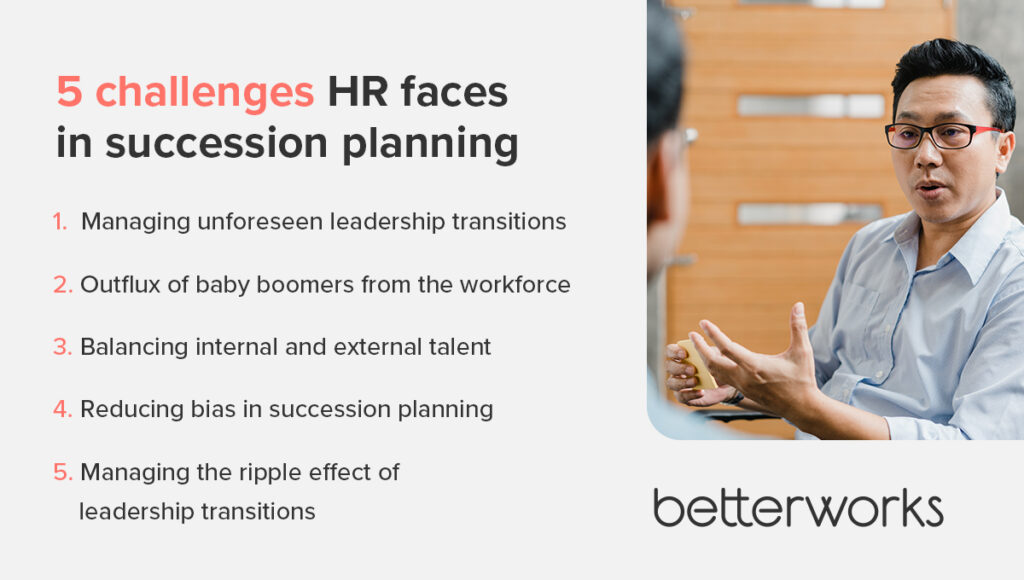
Embrace HR’s role in succession planning
Through strategic initiatives that identify, nurture, and prepare high-potential talent, HR leaders help create a resilient leadership pipeline capable of navigating both expected and unforeseen transitions. By aligning succession planning with broader business objectives, you can not only mitigate risks associated with leadership gaps but also drive long-term stability and success.
Ultimately, your strategic impact transforms succession planning from a reactive process into a proactive approach that secures your organization’s future.
Want to learn more? Check out the State of Skill Fitness in 2024.
Prep for succession tomorrow with transparent skill-building today.


